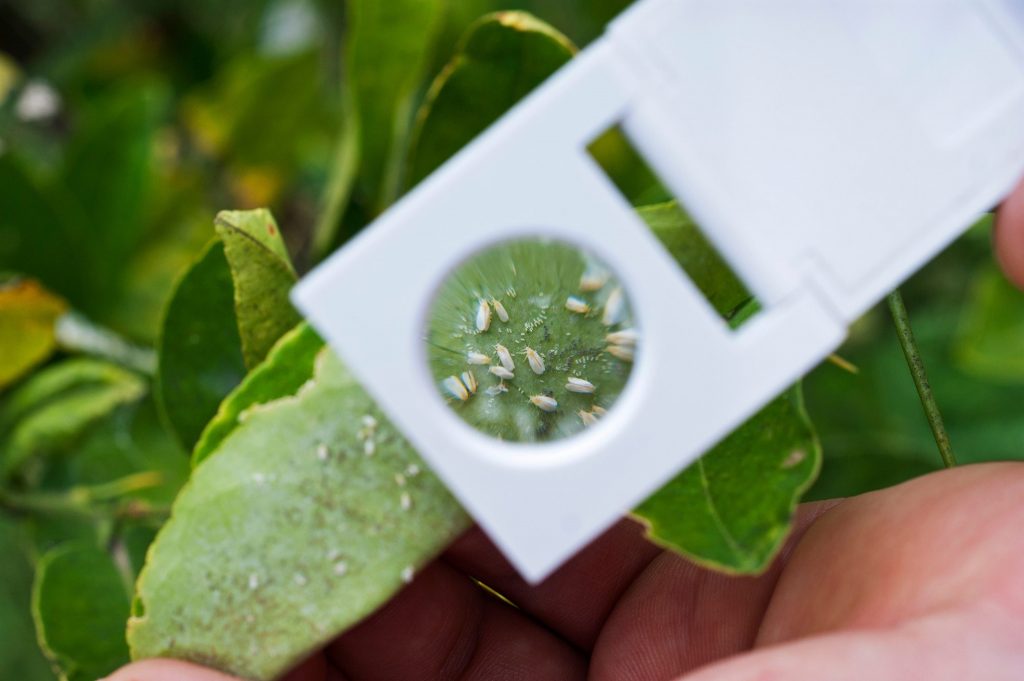
When talking with growers about spider mites or other pest infestation, we always hear the same questions: What and when should I spray?
To fully answer the question, we need to start at the beginning of all Integrated Pest Management (IPM) programs: the scouting.
Scouting is not only checking for insects, but also diseases, nutrient issues, height management, irrigation issues, stage of the crop, etc. by walking the crop and examining flowers, stems, roots and leaves. It seems to be a waste of time for valuable greenhouse employees who could instead be doing other tasks vital to the operation. However, a dedicated person is required for an accurate scouting.
With the help of detail-oriented employees, following our basic outline of scouting method should help control over most pests and can over time save money to your organization!
Prep the greenhouse
Proper scouting starts by dividing the greenhouse into areas. Spend a predetermined amount of time in each area, starting with plants nearest entryways where pests often come in.
Inspect plants
Growers know certain plants always have issues with specific pests. These plants must be watched and managed closely and will likely need preventative programs.
Proper scouting involves looking over the entire crop to evaluate overall color, height, and uniformness. Look for plants that are not like the others, and if any troubled areas stand out, start looking for pests.
Once this quick overall evaluation is complete, select plants at random for closer examination. We recommend using a hand lens of at least 10X magnification primarily to find pests, whereas fungal disease can usually be observed with the naked eye.
Inspect both the upper and lower leaf surface and the undersides of the leaves, flowers and stems. Pests are relatively unique to a defined location they prefer on plants. Turn over mature leaves and inspect carefully along the midvein where mites are usually first seen.
If you scout for root pests, some dwell in the soil, so don’t forget to remove a few plants from their pots in each section to inspect the roots.
Case of Spider Mites Spider mites tend to be located on the underside of the leaves unless the population has increased to an infestation level. Symptoms of spider mites are also visible on the upper side of the leaves as small stippling, caused by their feeding. This usually indicates too late of a diagnosis for many ornamental plants.
Monitor for pest populations
Yellow sticky cards, indicator plants and potato disks are commonly used to trap insects and monitor populations. Yellow sticky cards should be placed at regular intervals throughout the greenhouse, usually three to four cards per 1,000 square feet.

Make sure there are extra cards placed near doorways and vents.
Keep records
Make sure your scouting report keeps track of the pest life cycle and growing environment.
• Pest life cycle: Monitor the type of pest, quantity of pests and eggs present on the plant, pest life cycle (adults, larvae, eggs), developmental stage, crop issues and damage types.
• Growing Environment: Don’t forget to record information about the temperature, because it plays an essential role in pest development—the warmer the temperatures, the faster the life cycles are.
Know the crop’s economic threshold
Some growers may already have established their pest threshold level in their operations. If not, use the recording results from regular scouting to determine the crop or production pest threshold level. It is usually different for each crop: Stock plants are required to be as clean as possible – pest-free like, while vegetable crops have a significantly higher level of pest tolerated. Beyond the threshold, when the loss of the production due to pest infestation exceed the cost of pesticide, grower spray. However, when the loss is below the cost of pesticide investment, growers don’t spray.
Scout frequently
Frequent scouting provides the opportunity to detect and address problems before damage occurs. Therefore, we recommend scouting at minimum once per week and more often when conditions are favorable for problem pests. Be aware that the length of the day affects the growth and development of the pests, so adjust your scout according to long or short days as well.
We suggest scouting approximately three to four days after a chemical application or biocontrols release because it helps determine if the last application was successful.
cc kemin
